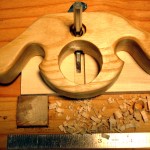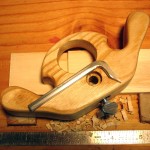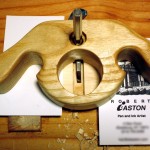Someday… Someday, I’m going to need a router plane. Router planes are used to clear the waste from a dado groove. I really don’t need the plane today, but have some projects in mind for the future that will need dado joints.

 I based this plane (also called an “old woman’s tooth”) on an example made by Derek Cohen. A bit of 5/4 ash left over from the Fiddlehead boat was the starting point. Shaping was much as Derek described; drill a few holes, cut the outline with the shopmade turning saw, refine with rasps. Now that I can shape metal, the tooth / blade was shaped from a hex key. Hand cranking the grinder to shape the blade burned off a hand full of mini Tootsie Rolls. A screw insert and a thumb screw were the last of the parts. A couple of coats of boiled linseed oil, followed by a coat of danish oil finished the job.
I based this plane (also called an “old woman’s tooth”) on an example made by Derek Cohen. A bit of 5/4 ash left over from the Fiddlehead boat was the starting point. Shaping was much as Derek described; drill a few holes, cut the outline with the shopmade turning saw, refine with rasps. Now that I can shape metal, the tooth / blade was shaped from a hex key. Hand cranking the grinder to shape the blade burned off a hand full of mini Tootsie Rolls. A screw insert and a thumb screw were the last of the parts. A couple of coats of boiled linseed oil, followed by a coat of danish oil finished the job.
 Yes, it cuts as intended. This hex key yielded a 1/4 inch wide blade, which will be handy for the intended projects. The method used to set the depth of cut is to elevate the tool on a couple of old business cards and then drop the blade to the wood surface and tighten the thumb screw. Now, remove the cards and cut. Repeat til done. By the way, it is a real good thing to cut from the outsides of a groove toward the center. That avoids tearout at the edges.
Yes, it cuts as intended. This hex key yielded a 1/4 inch wide blade, which will be handy for the intended projects. The method used to set the depth of cut is to elevate the tool on a couple of old business cards and then drop the blade to the wood surface and tighten the thumb screw. Now, remove the cards and cut. Repeat til done. By the way, it is a real good thing to cut from the outsides of a groove toward the center. That avoids tearout at the edges.
For those who have no old business cards for depth setting, use two aces out of a deck of playing cards. Leave them in the shop, so the next time you have friends over for poker, you know where at least two of the aces are.
Great job, Bob! And what a nice stealth art piece in the last photo. Is that the Parthenon, or a house in the NE of the country?
Thanks Al.
The drawing on the business card is a snip from a drawing of a 100+ year old mansion up here in the NE. See more of the drawing here.
Cool tool, Bob! You’re always making something in the shop that’s on my to-build list. :o)
Just curious about the wider hole above the hole that houses the cutter. Is that for a reason?
OK. We have to leave it to sharp-eyed Kari to find an embarrassing question to ask.
That larger hole was done with a forstner bit to get a very clean hole … because my smaller twist bits were leaving too much tearout in the ash … and because I didn’t have a correct size bit of any sort that didn’t produce tearout. Besides, we need more little nooks to collect shavings, dust, etc.
LOL! Sorry about that. But thanks for answering my question. I was quite puzzled.